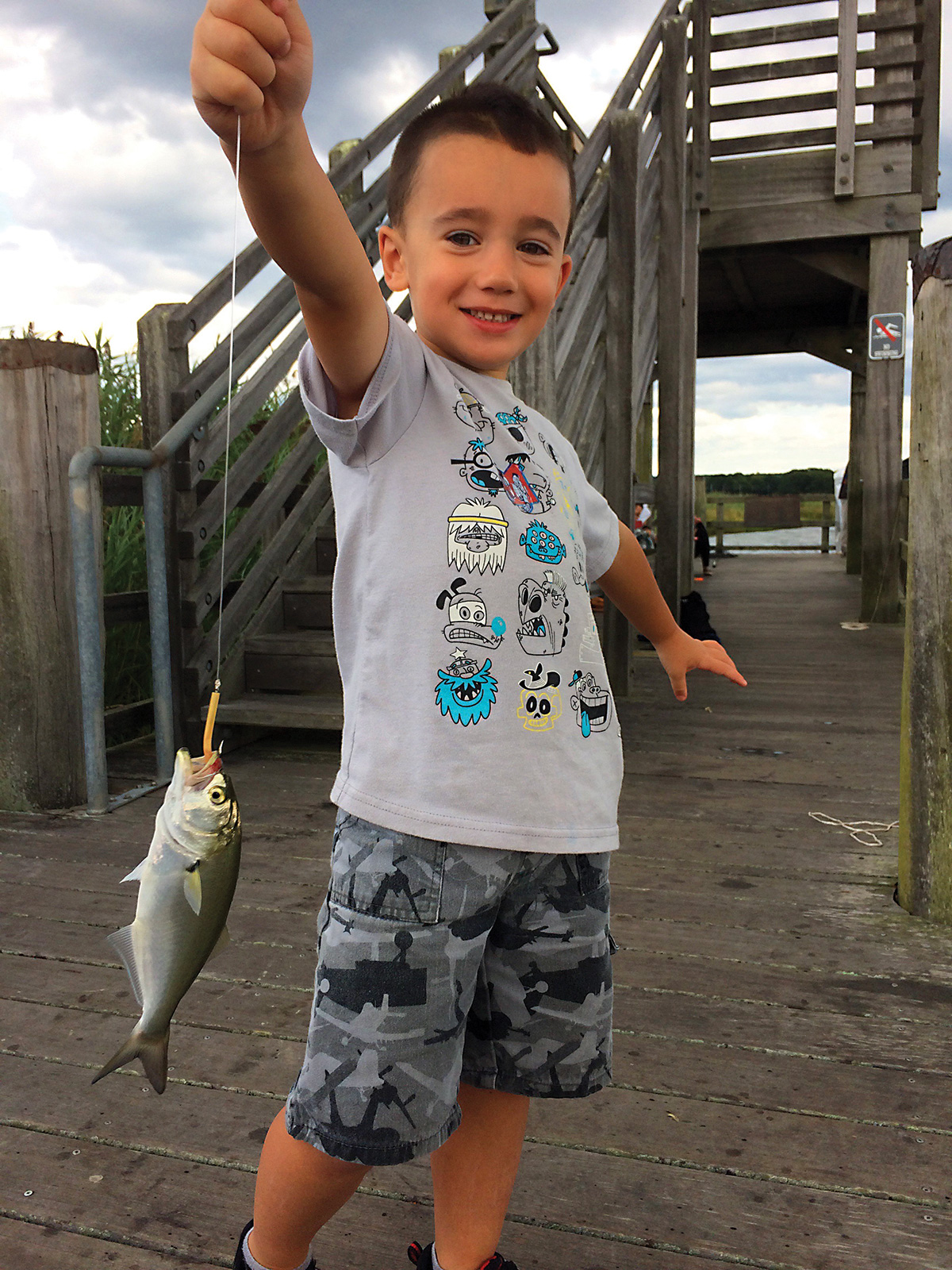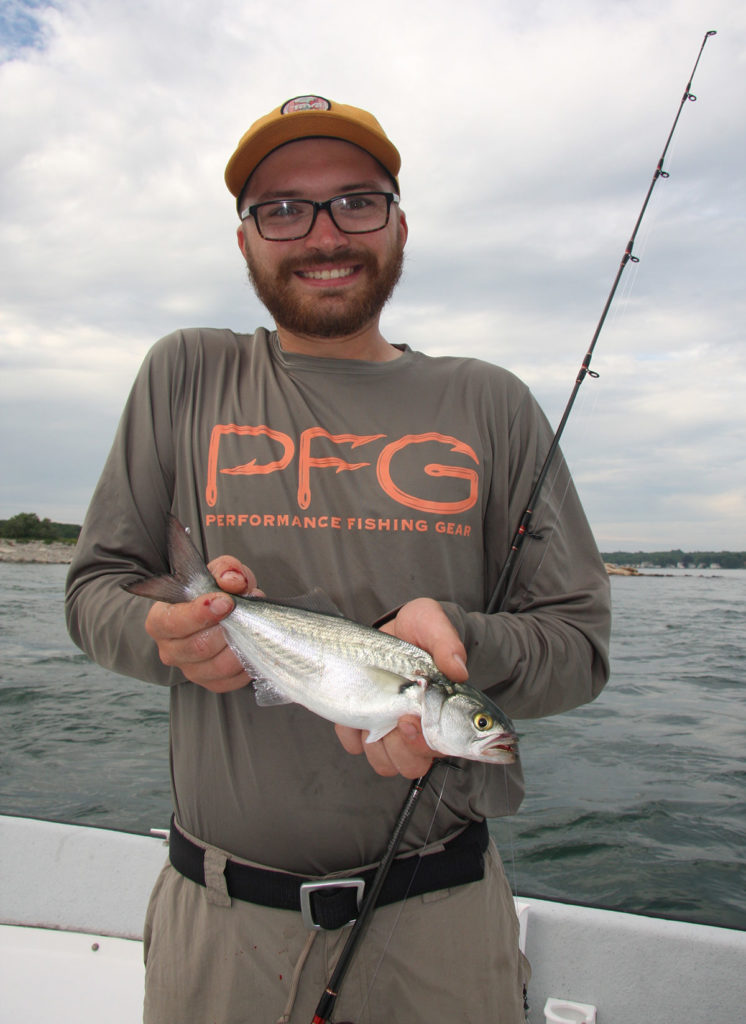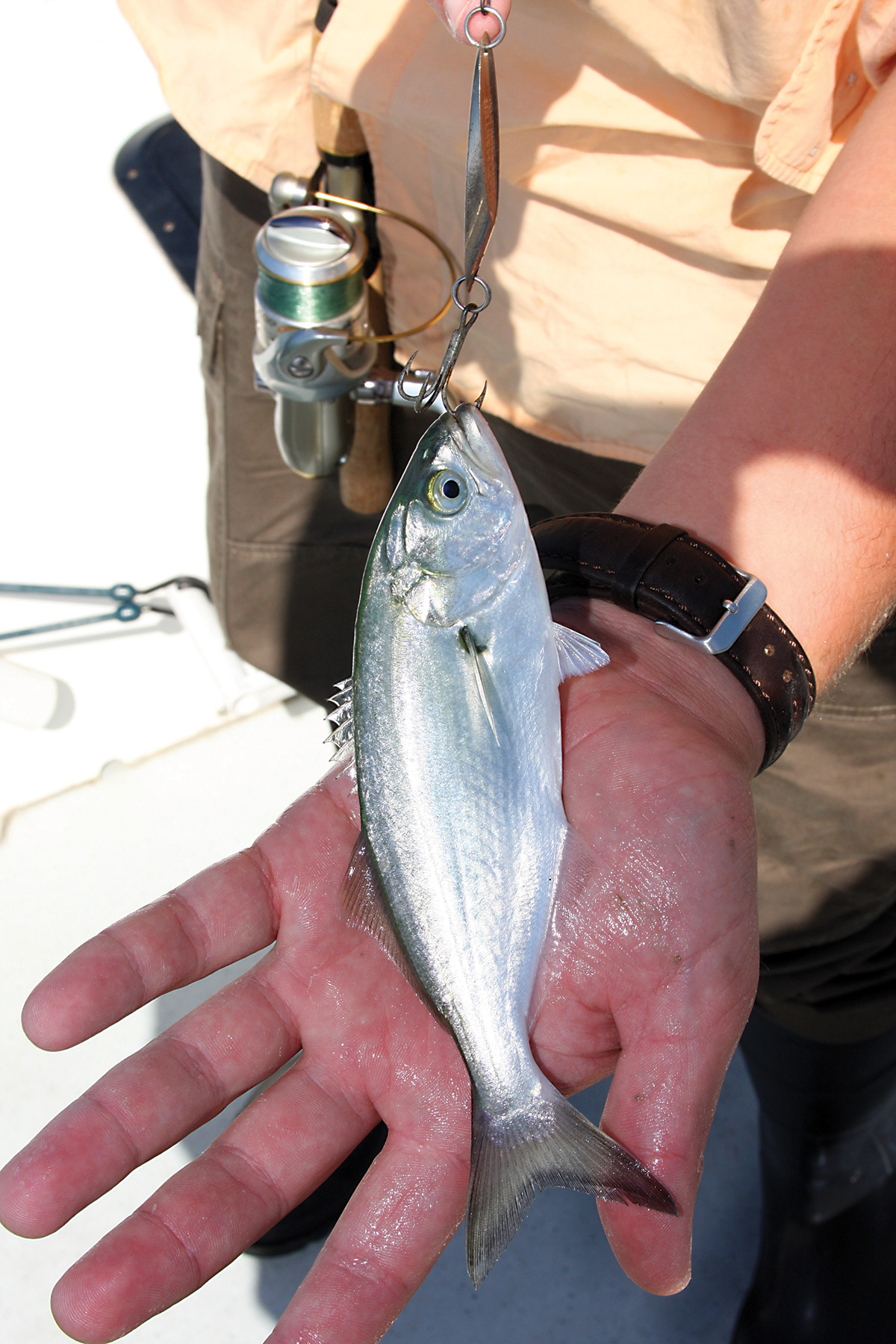
When I think of snapper blues I think of my youth. Countless memorable days in late August, sunburned shoulders, casting from a jetty in Madison, CT near my grandparents’ house. There was no 10-fish limit back then, and a bucket full of snappers fed the family fried-fish dinners for several nights. Today, the same excitement still thrills me when I feel one tugging on my spinning gear, fighting like a fish twice its size. Tigers cloaked in kitten bodies.
I’ve met anglers who believe snapper blues are their own species, and those folks were surprised to learn that “snappers” are simply baby bluefish. Anyone familiar with juvenile blues knows the name comes from the fast and fierce snapping of the jaws, which can inflict an impressive finger wound from even the smallest fish.
Snappers are young-of-the year bluefish, which become a “catchable” size of about 5 inches long when they invade our waters in late July and early August. They eat and grow at a remarkable rate, sometimes approaching nearly an inch per week. Late-season snappers reach at least 10 inches long before they migrate south in September, and are formidable opponents on a light outfit. They’ll strike at any lure smaller than themselves, making them a great target for young or beginner anglers and anyone looking for fishing fun on the saltwater.
Snapper Appeal and Locations
“When you find a school of snapper blues,” said Elliott Taylor, a snapper expert with 20 years’ experience in both CT and RI waters, “the bite can last all day, and you don’t need any special tackle to catch a limit. You don’t have to be a saltwater angler to get into snappers [although a saltwater license is necessary to target and/or harvest them], a lightweight freshwater rod will suffice, making these fish accessible to people of all ages and skill levels. Snappers, however, are not hardy fish—many don’t survive the catch-and-release process—so it’s best to have a plan for your catch, and stick to the limit only.
“You can find snappers close to shore, in estuaries and near structure like rock piles, docks and jetties where they chase bait like silversides, mummichogs and grass shrimp. Breachways and mini rip lines near shore often hold snapper blues, and nearshore tern activity is a great indicator the fish are there. Fleeing baitfish and small surface breaks are other exciting giveaways.”

Technique
The easiest technique for catching snappers is to fish a small metal lure. Using this method, you cast—from either shore or a boat—as far as you can and then slowly reel in. Small tin lures are designed to tumble and flash, imitating a wounded or escaping baitfish, which draws any snappers within sight. Snapper pros experiment with different retrieve speeds to see what works best on a given day—faster speed keeps the lure near the surface, and slower speed allows it to sink a bit. Generally, try to keep the lure about 2 feet below the surface with your rod tip near the water.
An advanced technique is to work a flat metal rapidly across the surface with your rod tip held high, which causes the lure to travel along the top like a jumping baitfish—the same concept as working a big surface plug for adult bluefish. The trick is to reel it as slowly as possible while keeping the lure skimming the surface. The commotion triggers aggressive strikes, and it’s fun to see the hits on top.
Despite their reputation as voracious feeders, bluefish of all sizes are sometimes fussy. Bait is often the answer when small blues hesitate striking tin lures. If you’re only stocked with lures, try dicing a silverside into tiny chunks and use a piece to sweeten the treble hook on your metal.
Other snapper experts are diehard bait anglers, which means using a snapper rig—purchased from a tackle shop or home tied—consisting of a small hook threaded with shiners and bobber or “snapper popper.” Set the popper to hold the bait about 18 to 24 inches below the surface. Cast your line a little way out from the dock or jetty and wait. Some anglers try to cast as far as they can, but that’s unnecessary with bait and may cause a soft bait to tear from the hook. Like fishing for freshwater panfish, when you see the popper dip below the water you know a snapper is biting.
“Gently but erratically retrieving snapper poppers will attract fish that are spread out,” said Taylor, “as will using small, freshwater, surface-popper lures with the first treble hook removed. In areas with a large concentration of fish, a very small tin such as a Kastmaster, Hopkins or Deadly Dick is most efficient.”
Tackle
An inexpensive, light and durable 5- to 7-foot, small spinning outfit and assortment of small metal lures are perfect for quickly loading up a limit on snappers. You can add to the fun and challenge by bringing along a small fly rod.
“I use ultralight tackle,” said Taylor, “like a 6-foot 6-inch Ugly Stik Intercoastal and small reel spooled with 10-pound mono finished with a short 20-pound fluoro leader. But slightly heavier saltwater rods to 8 feet will also work, especially if you’re expecting any type of larger fish mixed-in. Long casts and intermittent twitches during a quick retrieve with a 1/8-ounce silver Kastmaster from any craft, including a kayak or SUP, attracts plenty of attention from the ever-present summertime snappers. You can move up to a 1/4-ounce for bigger snappers later in the season. Four- to 5-weight fly rods are also an absolute riot for snapper blues using a minnow imitation or bucktail retrieved quickly.”
Snappers for Bait
In the absence of traditional baitfish like porgies or bunker, snapper blues make good baits for slammer bluefish and even striped bass, but the main use for snappers as bait is for late-season doormat fluke. Keeping within the 10-fish limit, you can fish snappers either dead or alive, and there are several approaches when doing so. Some pros rig the snapper in the same manner you’d rig a shiner for largemouth-bass—from the bottom lip through the top, typically off a traditional fluke rig, either with a fluke bomb or off a three-way swivel.
To fish the fluke bomb, start with a barrel swivel attached to a 3-foot section of 30-pound fluorocarbon leader. Tie in a 6-inch dropper loop at the mid-point of the leader, and attach a large, flashy teaser. At the end of the leader, attach a snap swivel to clip on a fluke ball heavy enough to hold bottom. Cut a second 3-foot length of 30-pound fluoro, and attach it to the 9 o’clock position on the fluke ball with another snap. Tie in a 5/0 Gamakatsu live-bait hook for your main bait at the trailing end of the leader. This rig works equally well with live or dead snappers.
To fish a snapper live, some people prefer to place the hook in the back, just in front of the dorsal fin. You can also hook them through the nostrils. They can stay alive this way for a length of time. If the snapper is dead, however, don’t fish them with the flared gill covers and bent up head, typical of their rigor mortis position, because they spin in the current. If that condition happens, cut off both gill covers and bend the body straight. Sewing the mouth shut helps, too.
Other fluke pros “butterfly” the snapper bait by running a fillet knife from the tail up close to the head on both sides of the spine. Some experts then remove the spine for an unobstructed flutter action.

Snappers in the Skillet
Many people don’t like eating bluefish, and therefore won’t eat snappers. But snappers don’t have the same dark meat and strong taste as adult blues. Their flesh is light and finely textured.
“They are great in the frying pan,” said Taylor, “just remove the head by making a diagonal cut behind the gill covers, cutting through the backbone. Gut the fish by pulling the head down, removing it from the body along with the entrails. Season to your liking with salt, pepper and oregano, and fry on medium heat until golden brown.” You then simply and easily eat the fillet off the backbone as you would a small trout.
The Elusive Striper
“These juvenile bluefish,” said Taylor, “also work great as live bait for large striped bass. When I was 10 years old, I was out in our Merrimac canoe with my father near a rock pile on Quonny Pond in Westerly, RI. We watched pods of bait swirling with packs of snapper blues meticulously corralling and devouring the peanut bunker and shiners. We were casting small Kastmasters and slowly filling our two-person limit for dinner. Suddenly, a large striper erupted inches from the boat, startling us, and taking a mouthful of bait and snappers with it. Frantically, we casted hoping to catch the bass, but to no avail. Since then, I have landed several 15- to 35-pound stripers using snapper blues.
“Catching your bait can be just as fun as catching your target species. Snapper fishing is consistently fast-paced, making it a quick cure for the fishing bug when other fisheries are slow in late summer.”


